
BigJimFish
Written: Nov 23, 2023
Table of Contents:
– Background
– Look and Feel
– Reticle Options
– Comparative Optical Evaluation
– Mechanical Testing
– Summary and Conclusion
– Your Pro and Con Breakdown
– Testing Methodology
Background:
Optisan is a Taiwanese optics company with it’s manufacturing facilities in China that does a lot of OEM work for many scope brands you are familiar with and also has a small in-house brand of its own. As with a few other OEM’s that also run small in-house brands, I have found Optisan’s products to generally outperform most competing products in terms of optical performance for the dollar. Many of you will probably remember the reticle I designed a few years ago for the Optisan CX6 1-6×24 rifle scope. I caught up with the Optisan folks again this year at SHOTShow and liked the look of a new small ffp hunting scope that represents the direction I see hunting scopes going in general. Since it fit into the price bracket of this year’s reviews, I thought it might make a nice crossover hunting / precision rifle inclusion.
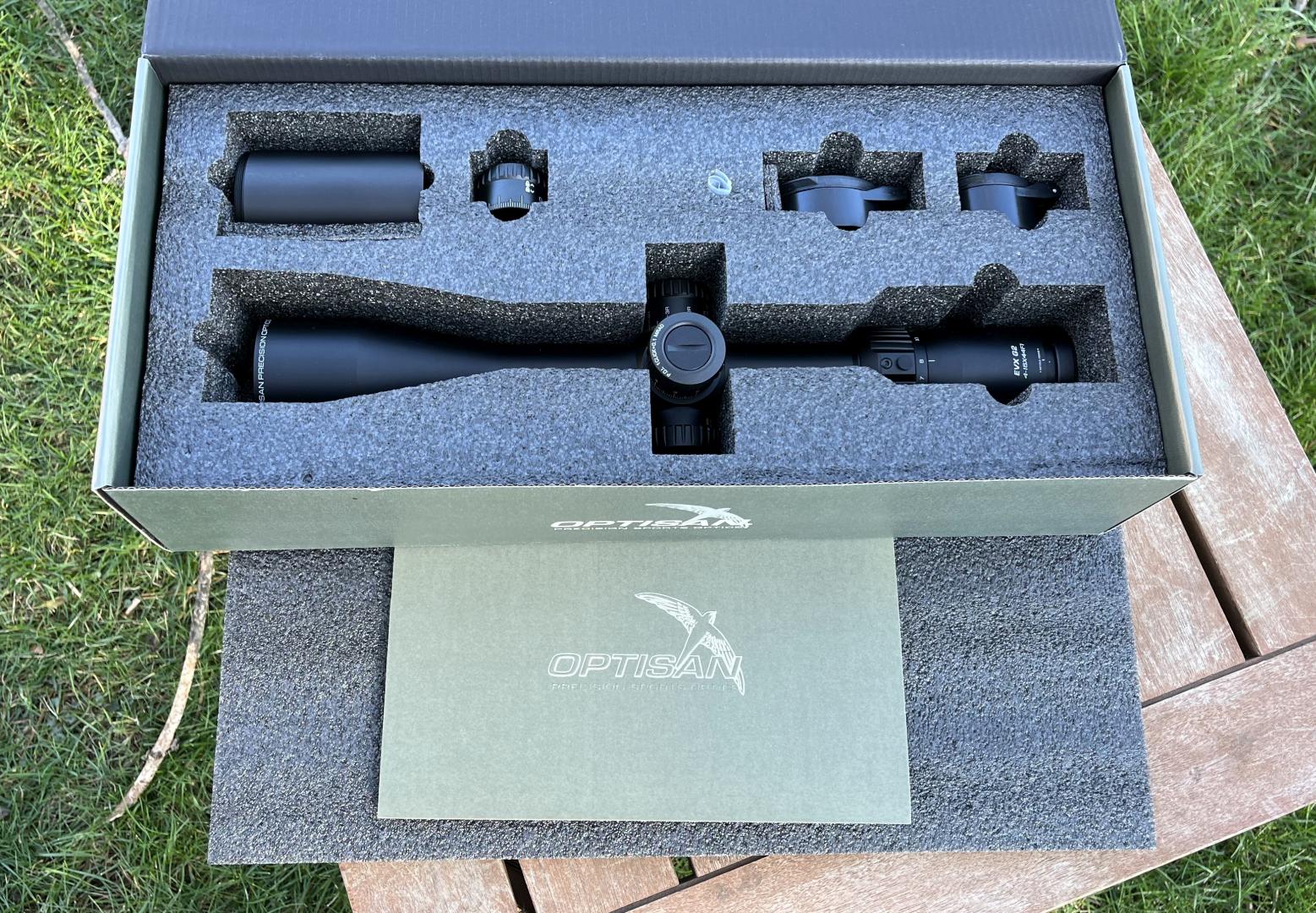
Look and Feel:
In stark contrast with most other products at this price point, Optisan has put a lot of work into the unboxing experience. Stylistically, the box has a very sophisticated appearance with clear influences from Swarovski and Vortex in the styling and color scheme. Opening the box, you are greeted with an envelope reminiscent of an invite to a fancy event embossed with Optisan’s name and logo. Inside you will find a ‘thank you’ along with the owner’s manual, dimensioned reticle diagram, and ten-year warranty card. It’s a nice experience: you’re going to feel special in spite of yourself. It shows what you can gain with care and attention to detail, as the box itself does not appear more expensive to manufacture than many of the solutions others are using, but the experience is substantially better.
Once the substantial closed cell foam is removed, you will see that the Optisan EVX Gen II 4-16x44F1 comes with one of the most complete sets of extras I have ever seen with a scope. Sunshade, flip caps, detachable throw lever, lens cloth, and even a spare elevation turret are all included. The spare elevation turret is marked only with 0 and the mil hash marks so that you may write your own distances on it. Presumably, you could do this with grease pencils or perhaps on a piece of masking tape. It’s a pity they did not go with a white background as on the optional $100 race dial Burris makes for its XTR III, as writing on scotch tape with a sharpie is easier and more weather-resistant than writing on masking tape or using a grease pencil. Still, an extra dial for your own markings is a big win as far as extras go. It is also a lot more cost-effective and versatile than having a custom knob made and engraved, as is popular with many hunting optics.
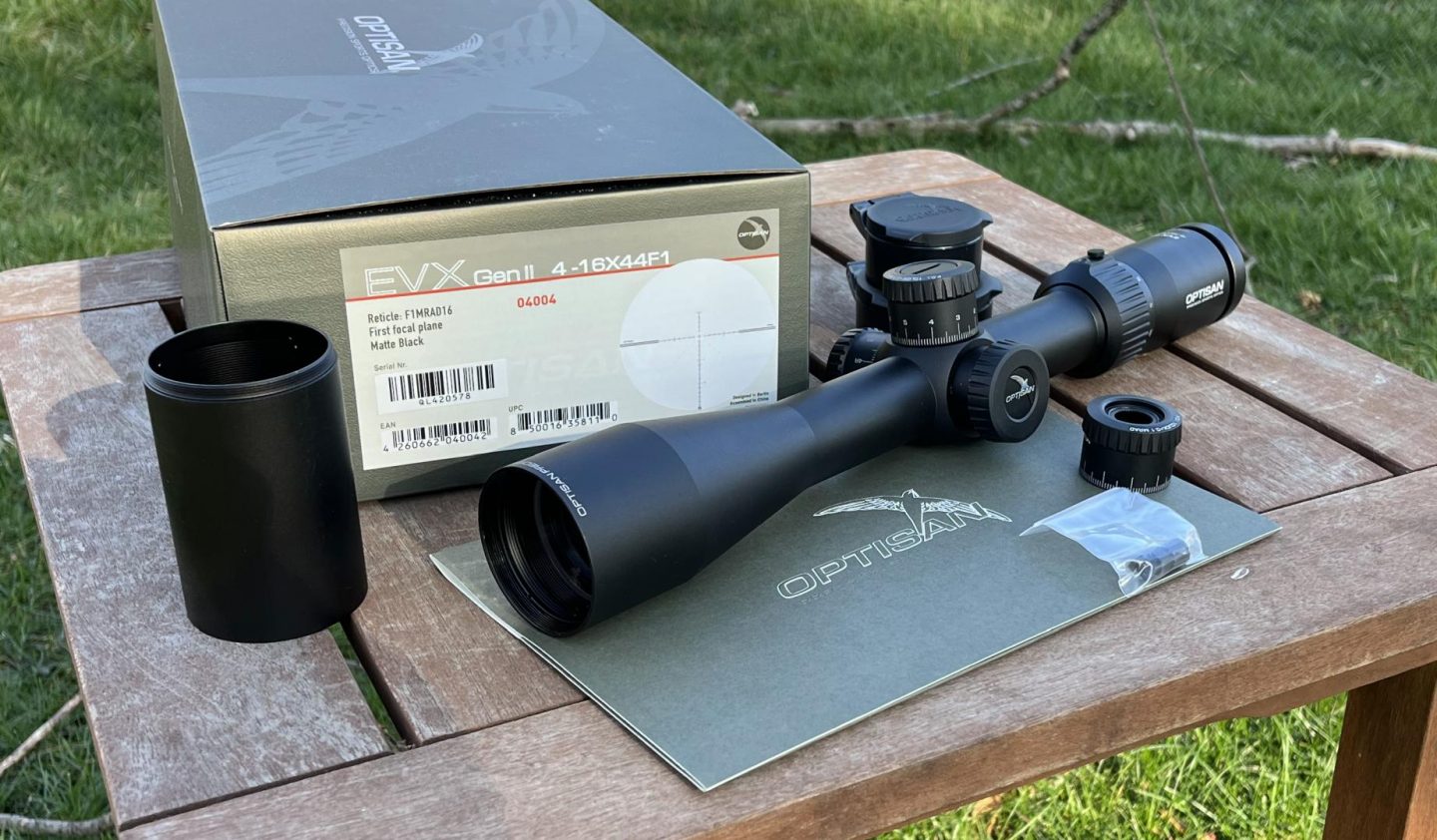
As you might expect from the 44mm objective size and 30mm main tube size, the EVX is a slim and light package. Its weight comes in at 26oz, making it one of the lighter long range optics I have tested. In appearance, it has the look of a European hunting scope, with small turrets and a pretty hummingbird logo.
Those adjustment turrets pull up to lock and push down to unlock. The zero is repositioned by unscrewing a cap on the top of the turret, pulling the outer cap up and off, and replacing it at the new zero position. There are no set screws involved in this and there is also no zero stop. The turret feel is very smooth and of higher than average resistance with little tacticle feedback but very loud audible clicks. It is not hard to count your clicks and I did not have any difficulty losing track or having some clicks skipped over. Function and feel of the elevation and windage turrets are the same. Parallax adjustment is in the normal left side position and stretches from 10yds to infinity. Parallax control moves with about average resistance, whereas the power ring is a bit on the stiff side and the euro style diopter is way too loose. You’ll probably want to keep a cap on that or tape in it place to keep it from wandering. The total power ring throw is about 200 degrees and the throw lever stud can be mounted in just one position. In this position, it moves from just below horizontal on one side to just below on the other.
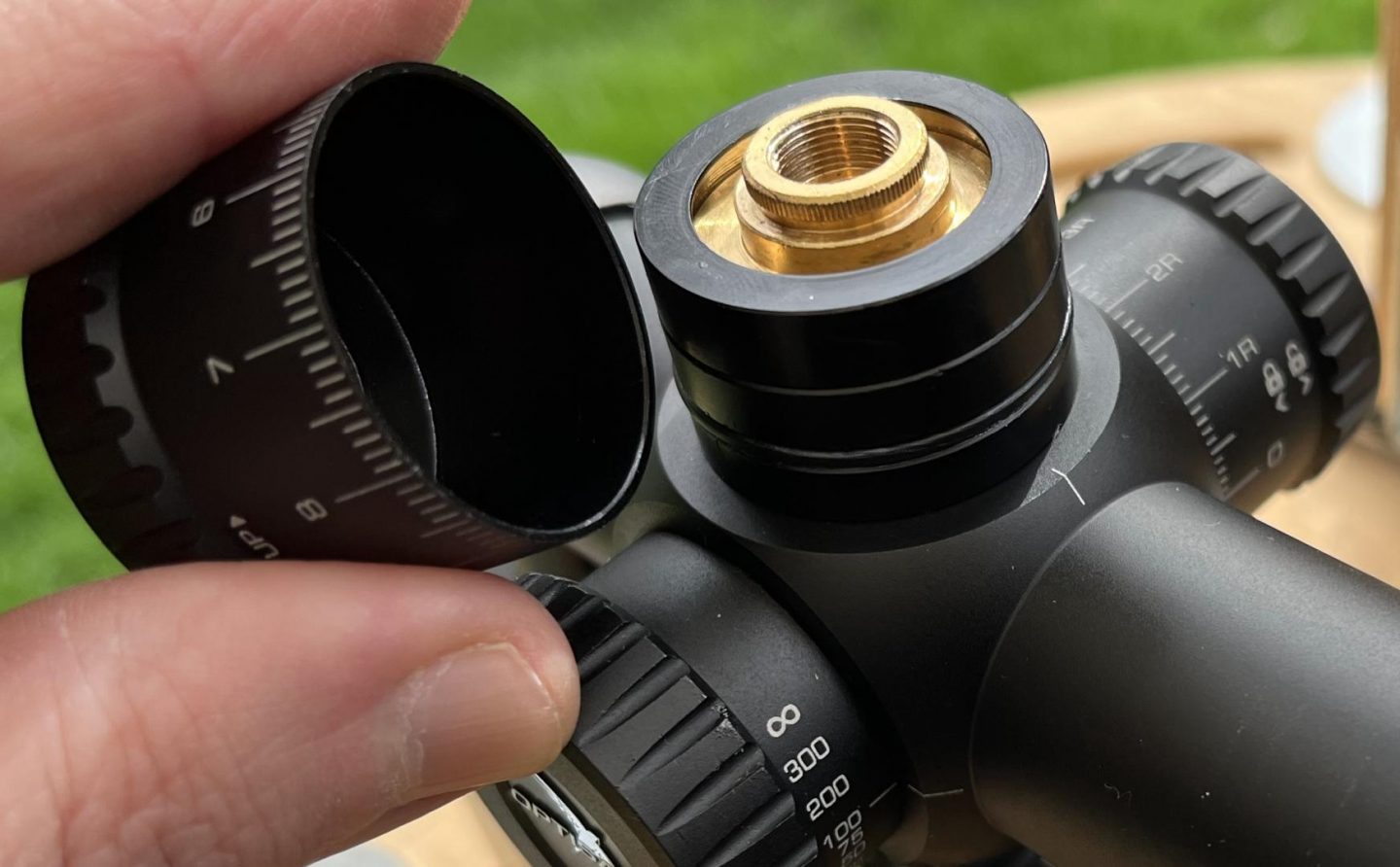
Reticle Options:
At the time of this writing, the Optisan EVX Gen II 4-16x44F1 comes in one moa / moa configuration and one mil / mil configuration. Each configuration has a single reticle option designated, quite rationally, either F1MOA16 or F1MRAD16. These reticles are very similar in appearance aside from the graduations. The F1MRAD16 one I have features a truncated 12 o’clock post with just 5 mils of graduations above the center, 8 mils of graduations each direction on the horizontal crosshairs, and 15 mils of graduations on the 6 o’clock post with labels for the 5 and 10 mil stadia. The graduations on the reticle are a consistent .5 mils. Lastly, there is a very truncated tree function that has dots positioned only at what you might say are the ends of the tree branches at 1-1, 2-2, 3-3 and so forth to 5-5. Overall, I would say the reticle is an interesting minimalist take on a precision rifle tree style reticle. It doesn’t have as many labels and graduations as I would generally like on a precision rifle reticle, but it is open and intuitive. I think it fits the crossover hunting / precision rifle purpose well. It is minimalist and not confusing, while still having the necessary features and graduations.
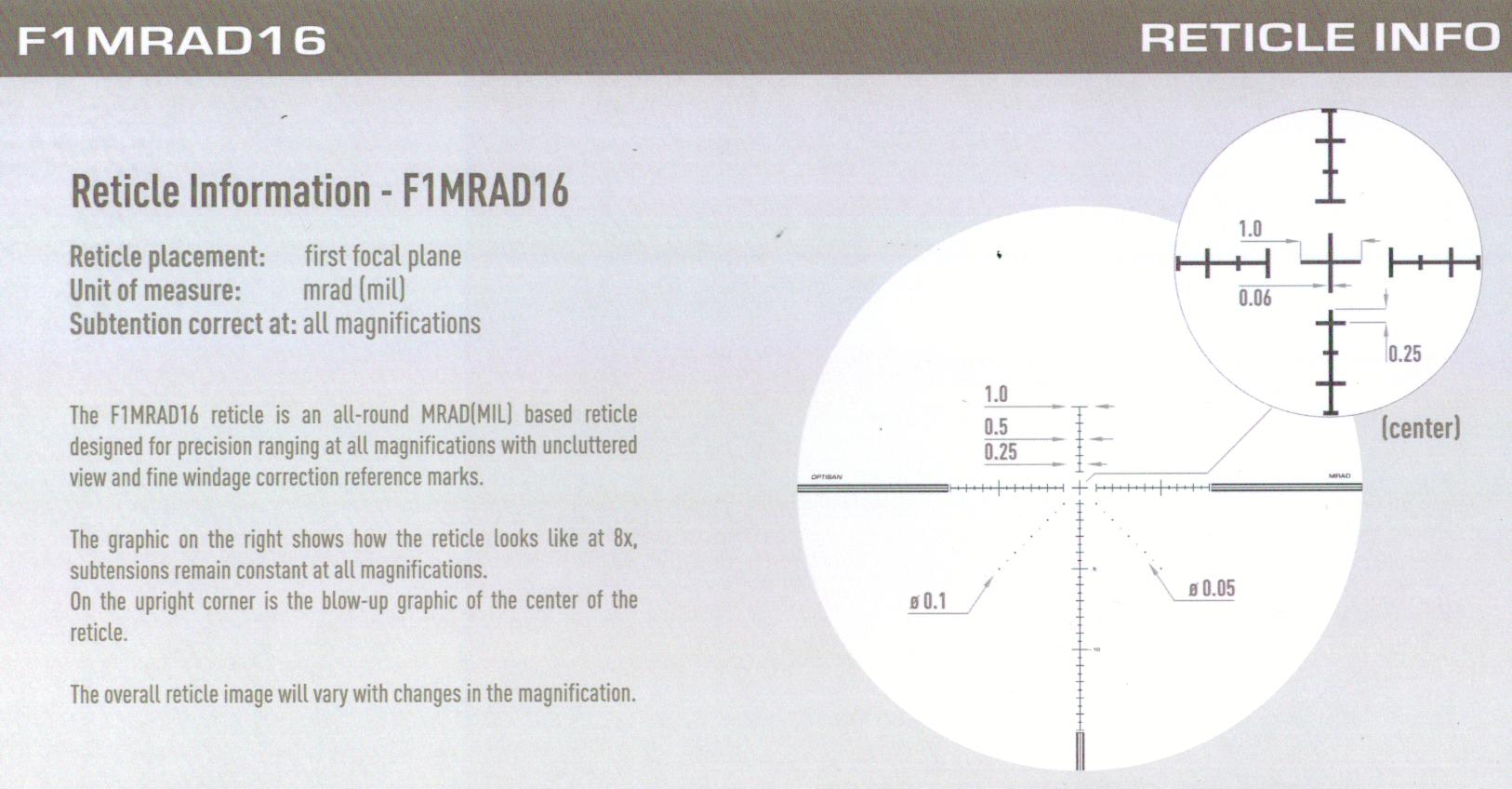
In my test scope, the reticle size was off less than 1% from spec and showed only about .05 mils of cant in 10 mils of travel. This is solid performance and would make the QC numbers for most, if not all, competing scope makers. I should also note there are a couple very, very small particles on the reticle in the upper left quadrant. I do not think they are dust as they are way, way too small. I expect they are tiny specs of whatever is being used to fill the reticle etching. The particles were small enough I did not notice them the first several times I used the optic, only later against a white background.
Comparative Optical Evaluation:
I’m currently showing $580 online for the Optisan EVX Gen II 4-16x44F1. This makes it one of the lowest cost options in my sub ~$1k lineup, in addition to having the smallest objective at 44mm and smallest main tube at 30mm. You might be forgiven therefore for expecting it to be one of the lowest performing optically. It is not. Optically, it is actually just above average. I would place it slightly above the Bushy Match Pro 5-30×56 and just behind the Athlon Midas TAC 6-24×50 in a very tightly packed, and generally well-performing, mid-section of the field. All three of these scopes are very close in performance and feature well-optimized optical designs.
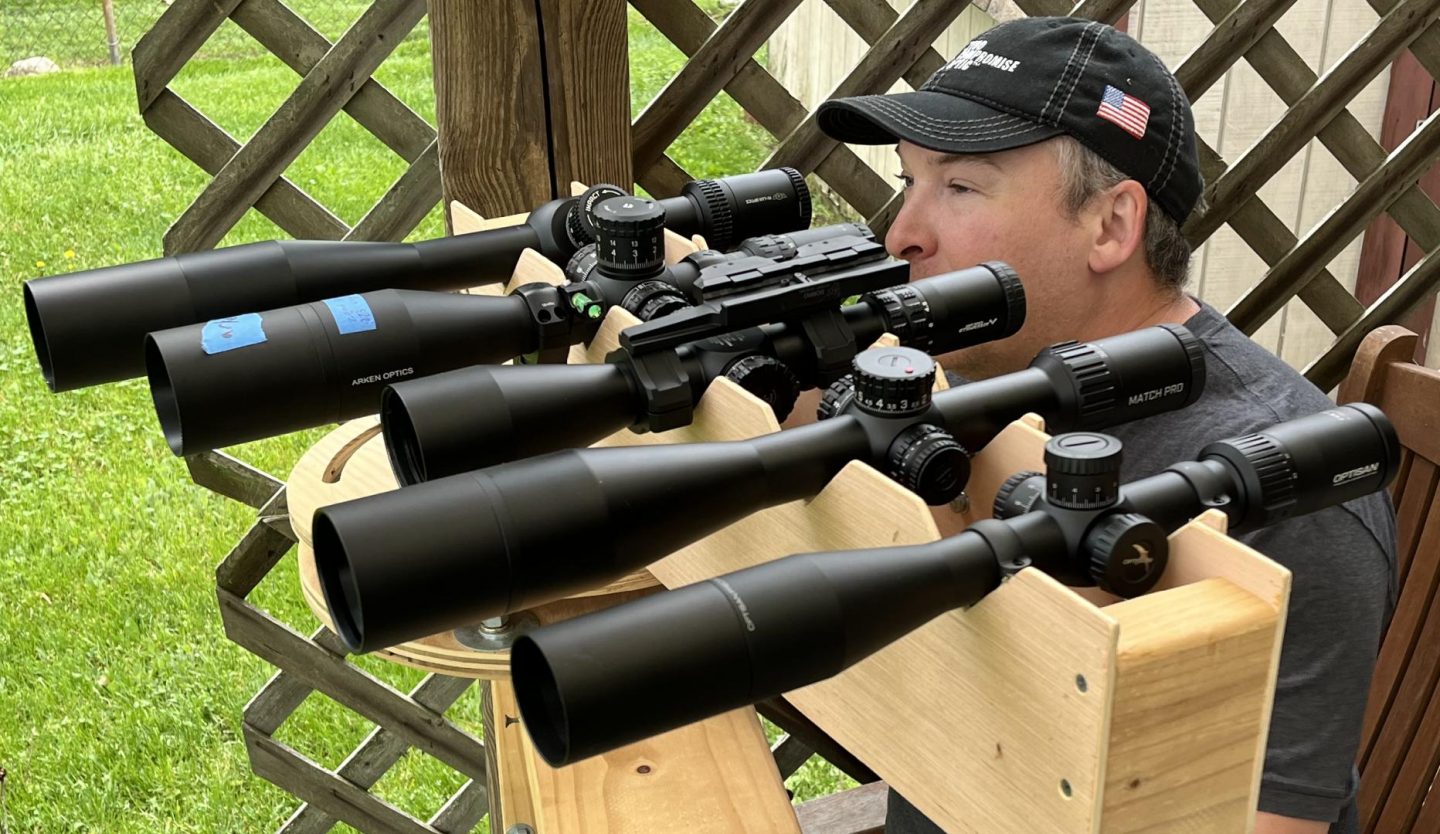
This position, just to the better side of center, is where the Optisan EVX Gen II 4-16x44F1 lands on both resolution and contrast. On chromatic aberration and eyebox, it performed well above average. However, in depth of field and in low light performance (unsurprising, given its objective size), it was well below average. The EVX showed slight pincushion distortion, though that is not particularly important on a scope of this magnification. Its field of view is below average. The EVX did not show any particular problems with stray light handling.

Given the lower than average cost and smaller than average size, I would characterize the Optisan EVX Gen II 4-16x44F1’s overall optical performance a win. It is outperforming its price and size. This is what I have generally come to expect from Optisan.

Mechanical Testing:
Most scopes have some deviation from perfect adjustment magnitude, though they are generally doing far better now than just a few years ago. This adjustment magnitude error will vary from example to example within the same model of scope. This is because it is not a product of design errors but rather variances introduced within manufacturing and, particularly, the assembly. Thus, the performance of my test samples is a piece of information with only limited value due to representing only one example. Often, we measure adjustment magnitude error as a percentage such that a scope whose reticle moves 10.1 mils when adjusted 10.0 mils tracks at 101% and one whose reticle moves 9.9 mils when 10.0 is dialed tracks at 99%. Frank has helpfully compiled a list of adjustment deviation of all scopes he has tested in class that can give you an idea of how often, and by how much, adjustment magnitude deviates from ideal.
When adjusting up from zero, the Optisan EVX Gen II 4-16x44F1’s I tested read 10.1 mil on target when adjusted 10.0 mils on the knob. This equates to 101% on Frank’s scale and represents probably about average for scope adjustment magnitude performance these days. Total adjustment range up from zero was 12.6 mils. Adjusting down from zero, the EVX goes to 11.7 mils on the adjustments and shows the same 1% deviation as when adjusting up. This adds up to something like 24.3 total mils of adjustment.
The windage knob on the Optisan EVX Gen II 4-16x44F1 does not have any rotation stop so you can utilize the full adjustment range. In practice, this was 10.0 mils right and 13.2 mils left. When at 10.0 mils up on the elevation turret, the windage moved though this full range without tubing out. That is great, and also a bit unusual. Most scopes can be tubed out when at extremes in both elevation and windage, which is something shooters should be aware of. Though, from a hunting standpoint, you should never be shooting at a living animal at such extremes of adjustment, as your chances of a clean kill would be quite low.As should be expected, the Optisan EVX Gen II 4-16x44F1 showed no POI shift with power ring, parallax, or diopter adjustment and no noticeable spline slop. Its light clicks do mean you can move the turret slightly within a click, though I don’t think this probably matters in actual use. The EVX reticle showed less than 1% error in size and .05 mils worth of cant in 10 mils of travel. This comes out to about .29 degrees and is well within spec for most, if not all, manufacturers.
Summary and Conclusion:
I am quite pleased to see the basic features of precision rifle scopes crossing over into scopes intended for hunting. This Optisan EVX Gen II 4-16x44F1 is an excellent example of the trend. With a 44 mm objective, 30 mm tube, locking turrets, and weighing in at only 26 oz, it is exactly the form factor you want on top of a hunting rifle, but it also features the mil / mil graduation arrangement, front focal plane, and accurate click adjustments necessary to give you significantly more effective range. The only typical precision rifle scope features that it is missing are illumination and zero stop. I have never found significant use for illumination in a high-powered rifle scope, but the lack of a zero stop does limit the EVX’s appeal for rimfire use and for use in a competition setting. I don’t think hunters will find it much of a limitation, though, as the turret is 10 mils / turn and ethical shots do not involve either a whole lot of drop or a lot of rapid adjustment from shot to shot.
Beyond the concept and features, the Optisan EVX Gen II 4-16x44F1 is optically quite good. It performs well above what should be expected for the price, size, and weight. Similarly, the mechanical performance of the EVX sample I have is well within the tolerance range I would expect for scopes intended for precision rifle use. This is something that has not been the case for hunting scopes in the past and many companies have adjusted slowly to the idea that people might notice and care if their adjustments are off by 5% or so.
The main downside I see in the Optisan EVX Gen II 4-16x44F1 is that it features only a Euro style 10-year warranty and not the American style lifetime warranty. Lastly, their QC did miss some tiny specs on the reticle that, though tiny, are visible and contrast with what is otherwise a remarkably sharp, clean, and finely etched reticle.
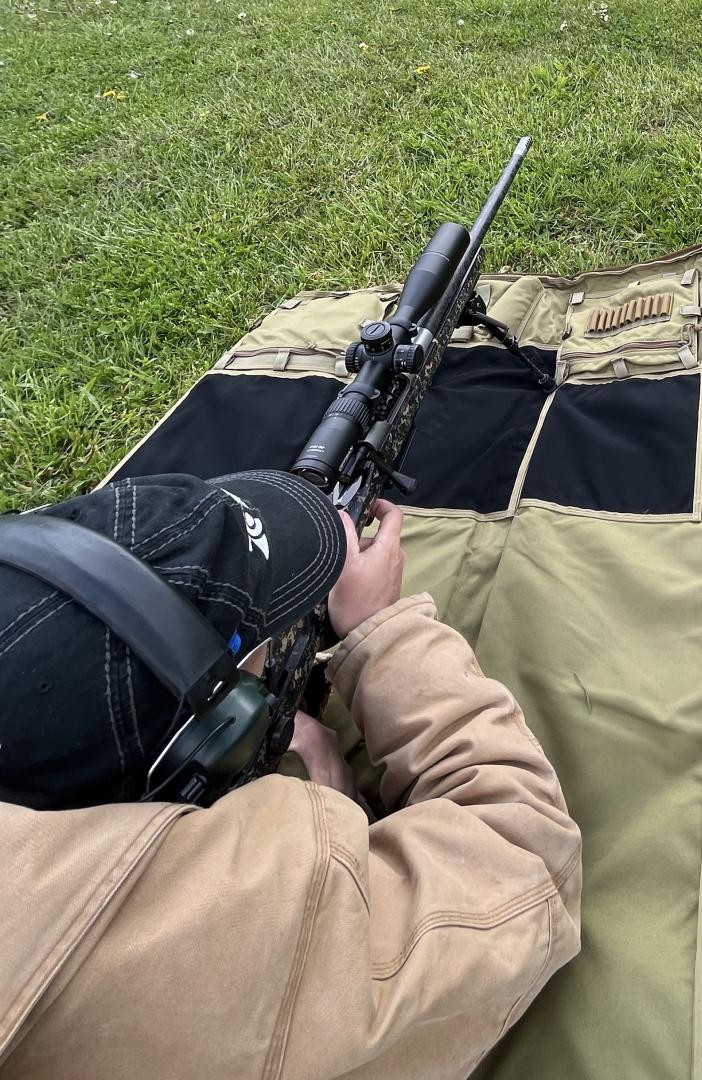
Other upsides I see for the EVX are the excellent set of extras included with the scope. This is a big deal, especially when it comes to lower cost optics, as buying accessories like caps or a sunshade aftermarket can often add quite significant percentages to the cost of the optic, whereas including them adds very little. making it a winning value proposition. The EVX goes even beyond caps, a sunshade, and a throw lever with the inclusion of a second elevation turret for you to put your own markings on.
Your Pro and Con Breakdown:
Pros:
– Excellent optical performance comparable with bigger, heavier, and more expensive scopes
– Good mechanical performance and no tubing out
– At 26 oz and 44 mm objective, it is light and small
– Great extras including caps, a sunshade, a throw-lever, and an extra elevation knob for you to customize
Cons:
– No zero stop or revolution indicator
– 10-year warranty is less than most brands offer

